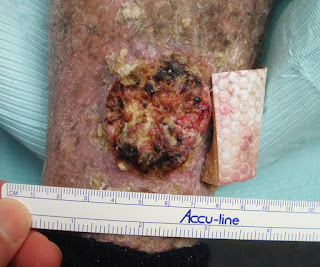This is the saga of a man whose care poses therapeutic dilemmas.
HPI: The patient is a 69 yo man with a greater than 40 year history of severe psoriasis. He was a research subject at a prestigious university hospital for many years. Over that time, he has received PUVA, methotrexate and an investigational drug, Rapamycin. He has been treated with NB UVB and acitretin with some improvement. As a result of his therapies, he has developed numerous squamous cell carcinomas. These pose therapeutic challenges They are painful, foul smelling and difficult for the patient to care for. An additional problem is occasionally disabling trigeminal neuralgia. He has had many well-differentiated SCCs excised over the past decade. He has atrial fibrillation, Factor 5 deficiency and is on warfarin and a host of cardiac medication.
O/E: Wide-spread erythema and scale covering entire integument except head and neck. There is a 3 cm exophytic tumor of the left pre-tibial area and smaller similar tumors on right leg, back and chest.
Clinical Photos (6.6.17)
 |
| L. Pretibial |
Diagnosis: Generalized psoriasis, Squamous cell carcinomas
Questions: Should these lesions be excised? Should we consider one of the new targeted therapies? Do any of our members have expertise with them? This man has a number of co-morbidities which may make therapy more difficult.
References:
Oral therapy for nonmelanoma skin cancer in
patients with advanced disease and large tumor burden: a review of the
literature with focus on a new generation of targeted therapies.
Rudnick EW, Thareja S, Cherpelis B. Int J
Dermatol. 2016 Mar;55(3):249-58
Author information
Abstract: This review of the literature
aims to describe previous and current treatment options for oral therapy in
locally advanced and metastatic NMSC otherwise unamenable to standard
treatment. Oral Smoothened (Smo) inhibitors Vismodegib, Sonidegib, and
Taladegib have shown to be effective in several trials. Oral tyrosine kinase
inhibitors Erlotinib and Gefitinib, which target epidermal growth factor
receptor (EGFR), have early supporting data and are currently undergoing large
multicenter trials. Oral therapy in NMSC is useful in high risk patients with
recurrent and aggressive disease who may not tolerate other systemic therapies.











